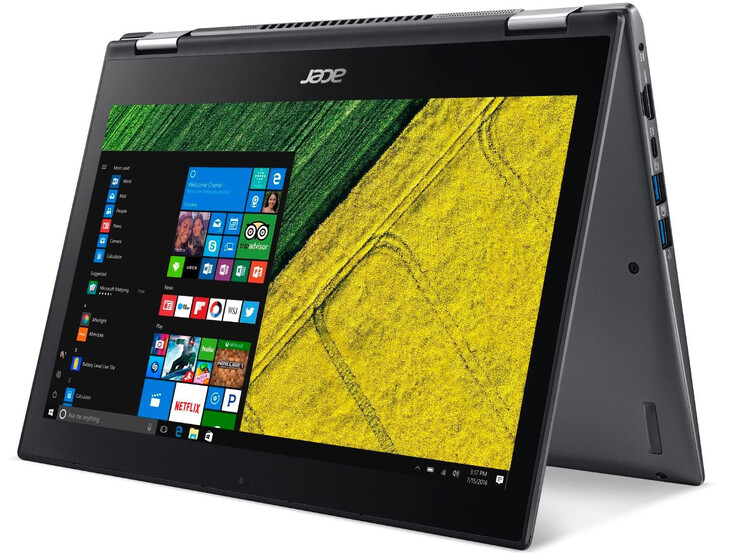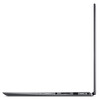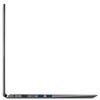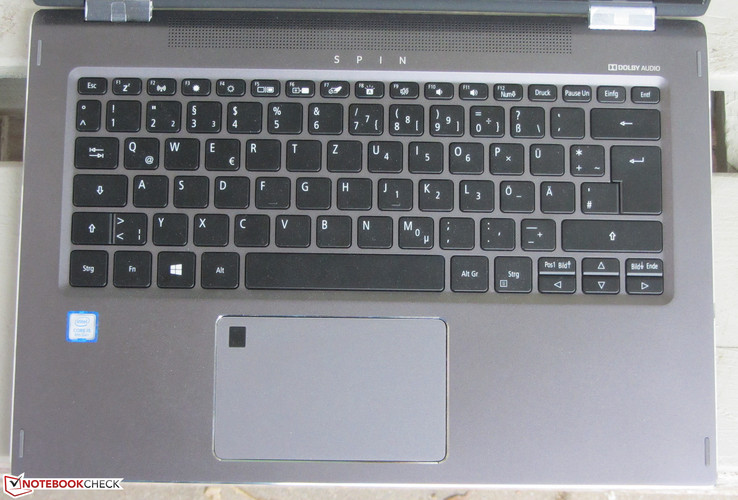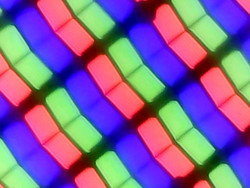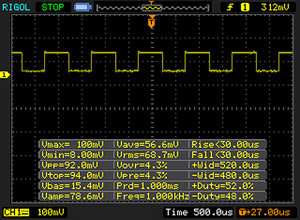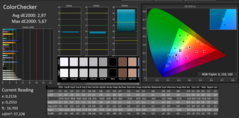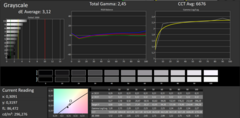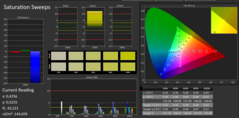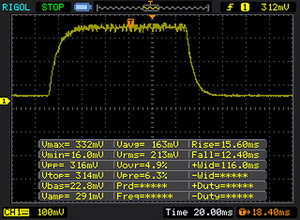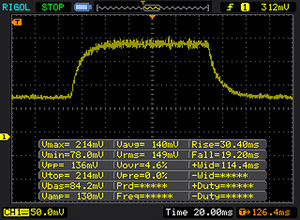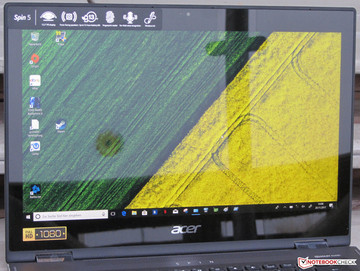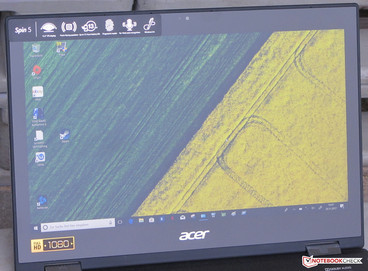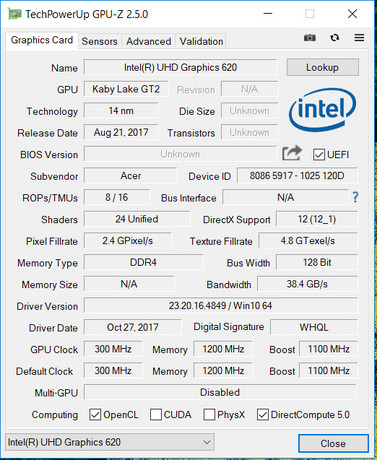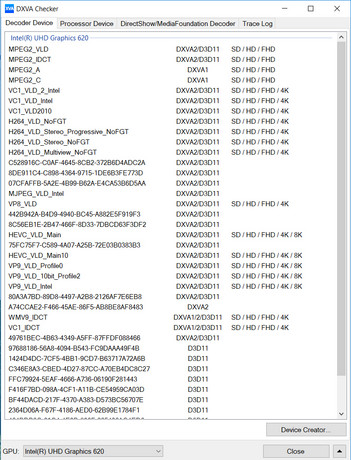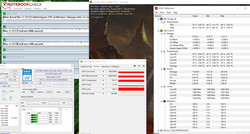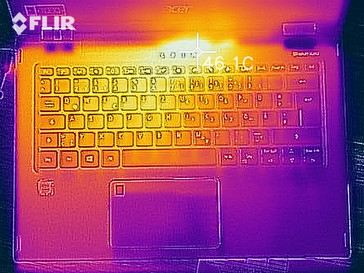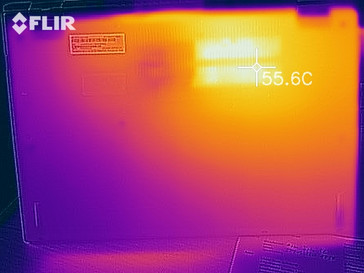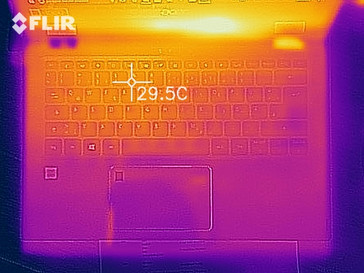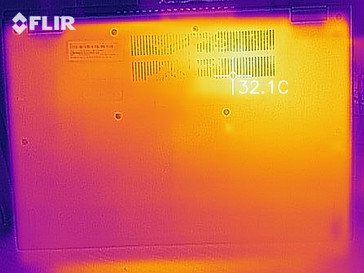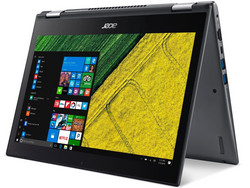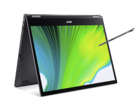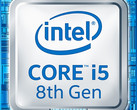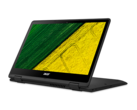Acer Spin 5 SP513-52N-54SF (i5-8250U, FHD) Convertible Laptop Review

For the original German review, see here.
Acer packs the Spin 5 SP513-52N's inner workings into a classy aluminum case. The computer runs on a quad-core ULV processor. The new device distinguishes itself from its direct predecessor – the Spin 5 SP513-51 – both inside and out. Acer has successfully avoided making the same mistakes for which the SP513-51 was criticized. The new laptop's competitors include devices such as the Lenovo Yoga 720-13IKB and the Asus ZenBook Flip UX360UAK-BB351T.
Case & Connectivity
The Spin 5's case is made of aluminum in the color steel gray. The device proves to be well-manufactured. The fine gaps where the pieces join are even, and there are no protrusions. The case's stability is mostly flawless, although the base unit could be a little more rigid. The battery is permanently installed, and the computer lacks a maintenance hatch. In order to reach the inner workings, all the screws on the bottom of the device must be removed. Afterward, the bottom shell detaches quite easily.
Acer has made significant updates to the Spin 5's array of ports. The SP513-52N is equipped with an HDMI connection and three USB Type-A ports (2x USB 3.1 Gen 1, 1x USB 2.0). The laptop also boasts a Type-C port (USB 3.1 Gen 1) that supports DisplayPort over USB-C. Using an adapter that can be purchased separately, this technology enables the Type-C port to function as a second video output. The Type-C port can also be used to charge the battery, though the USB charging device must have a power rating of at least 45 watts and a voltage supply of 15 to 20 volts. We tried it out with a 45-watt power supply (Inateck UCC1001DE) and can confirm that the battery does indeed charge. An 18-watt power supply was not able to charge the device.
Whereas the SP513-51 had to make do with just a microSD card reader, Acer has fitted the SP513-52N with a full-fledged SD card reader. However, it is not one of the fastest of its kind. While copying large blocks of data, the reader reached a maximum transfer rate of 25.2 MB/s. The card reader transferred 250 JPG image files (each around 5 MB) at a speed of 23 MB/s. We test memory card readers with a reference memory card (Toshiba Exceria Pro SDCX 64 GB UHS-II).
The WLAN module carries a Qualcomm QCA6174 chip. Along with the WLAN standards 802.11a/b/g/n, the chip also supports the fast ac standard. Our WLAN test, which is performed under optimal conditions (no other WLAN devices in the vicinity, short distance between the laptop and the server PC), revealed data transfer rates in the average range.
Connections
| SD Card Reader | |
| average JPG Copy Test (av. of 3 runs) | |
| Asus Zenbook Flip UX360UAK-BB351T (Toshiba Exceria Pro SDXC 64 GB UHS-II) | |
| Asus VivoBook Flip 14 TP410UA-EC242T (Toshiba Exceria Pro SDXC 64 GB UHS-II) | |
| Acer Spin 5 SP513-52N-54SF (Toshiba Exceria Pro SDXC 64 GB UHS-II) | |
| maximum AS SSD Seq Read Test (1GB) | |
| Asus Zenbook Flip UX360UAK-BB351T (Toshiba Exceria Pro SDXC 64 GB UHS-II) | |
| Asus VivoBook Flip 14 TP410UA-EC242T (Toshiba Exceria Pro SDXC 64 GB UHS-II) | |
| Acer Spin 5 SP513-52N-54SF (Toshiba Exceria Pro SDXC 64 GB UHS-II) | |
Input Devices
The Spin 5 comes with a backlit chiclet keyboard. The flat, smooth keys have a short travel and a clear click point. The keyboard does not bend during typing. All in all, Acer has produced a good keyboard that is quite suitable for prolonged and frequent use. The backlighting is controlled via an Fn key and offers only one brightness setting. As usual, the light turns off after a few seconds. As soon as the user presses any key, the light turns back on. It is not possible to activate the backlighting to run continuously. The length of the interval before the light turns off cannot be changed either. Normally settings for these functions can be modified in the computer's BIOS, but the Spin 5 lacks this adaptability.
The multi-touch capable ClickPad has a surface area of about 10.5 x 6.5 cm (~3.5 x 2 inches), providing plenty of space for the execution of touchpad gestures. Fingers glide easily across the pad's smooth surface. The pad has a short travel and a clear click point. The fingerprint reader is located on the upper-left corner of the ClickPad.
The Spin 5's capacitive touchscreen supports 10 touch points. It gave us no trouble and reacted to input immediately. It can be operated with fingers or with an active stylus (ASA630, available from Acer separately). The stylus offers 1024 levels of pressure sensitivity and costs around 40 Euros (~$50; similarly priced in the US).
Display
The Spin 5's 13.3-inch touchscreen display has a native resolution of 1920x1080 pixels. The contrast (1093:1) is good. The brightness (275.87 cd/m2) should be substantially higher – we expect over 300 cd/m², here, especially considering the convertible laptop's price and the environments in which it may be used.
Unfortunately, at brightness levels of 20% and under the display uses PWM backlight flickering at a frequency of 1000 Hz. Even so, a frequency in that range should not cause eye problems and/or headaches, even for sensitive users.
| |||||||||||||||||||||||||
Brightness Distribution: 88 %
Center on Battery: 295 cd/m²
Contrast: 1093:1 (Black: 0.27 cd/m²)
ΔE Color 2.97 | 0.5-29.43 Ø5
ΔE Greyscale 3.12 | 0.57-98 Ø5.3
94% sRGB (Argyll 1.6.3 3D)
62% AdobeRGB 1998 (Argyll 1.6.3 3D)
69.3% AdobeRGB 1998 (Argyll 2.2.0 3D)
94.6% sRGB (Argyll 2.2.0 3D)
69.8% Display P3 (Argyll 2.2.0 3D)
Gamma: 2.45
| Acer Spin 5 SP513-52N-54SF IPS, 1920x1080, 13.30 | Asus VivoBook Flip 14 TP410UA-EC242T IPS, 1920x1080, 14.00 | Lenovo Yoga 720-13IKB IPS, 1920x1080, 13.30 | Asus Zenbook Flip UX360UAK-BB351T IPS, 1920x1080, 13.30 | Acer Spin 5 SP513-51 IPS LED, 1920x1080, 13.30 | |
|---|---|---|---|---|---|
| Display | -1% | -10% | -6% | -40% | |
| Display P3 Coverage | 69.8 | 66.7 -4% | 65.3 -6% | 64.1 -8% | 39.99 -43% |
| sRGB Coverage | 94.6 | 96.6 2% | 83.7 -12% | 91.8 -3% | 59.5 -37% |
| AdobeRGB 1998 Coverage | 69.3 | 68.9 -1% | 61.2 -12% | 65.2 -6% | 41.32 -40% |
| Response Times | 800% | 20% | -23% | -7% | |
| Response Time Grey 50% / Grey 80% * | 49 ? | 34 ? 31% | 32 ? 35% | 36 ? 27% | 56 ? -14% |
| Response Time Black / White * | 27 ? | 29 ? -7% | 26 ? 4% | 27 ? -0% | 27 ? -0% |
| PWM Frequency | 1000 ? | 24750 ? 2375% | 50 ? -95% | ||
| Screen | 4% | -25% | -17% | -20% | |
| Brightness middle | 295 | 327 11% | 351 19% | 368 25% | 245 -17% |
| Brightness | 276 | 308 12% | 310 12% | 350 27% | 233 -16% |
| Brightness Distribution | 88 | 90 2% | 82 -7% | 87 -1% | 87 -1% |
| Black Level * | 0.27 | 0.23 15% | 0.37 -37% | 0.29 -7% | 0.21 22% |
| Contrast | 1093 | 1422 30% | 949 -13% | 1269 16% | 1167 7% |
| Colorchecker dE 2000 * | 2.97 | 2.63 11% | 5.03 -69% | 5.26 -77% | 4.2 -41% |
| Colorchecker dE 2000 max. * | 5.67 | 6.58 -16% | 12 -112% | 8.78 -55% | 8.75 -54% |
| Greyscale dE 2000 * | 3.12 | 4.11 -32% | 3.62 -16% | 5.87 -88% | 3.94 -26% |
| Gamma | 2.45 90% | 2.45 90% | 2.18 101% | 2.42 91% | 2.66 83% |
| CCT | 6676 97% | 7352 88% | 6323 103% | 6998 93% | 6096 107% |
| Color Space (Percent of AdobeRGB 1998) | 62 | 63 2% | 55 -11% | 60 -3% | 38 -39% |
| Color Space (Percent of sRGB) | 94 | 97 3% | 84 -11% | 92 -2% | 59 -37% |
| Total Average (Program / Settings) | 268% /
152% | -5% /
-16% | -15% /
-16% | -22% /
-22% |
* ... smaller is better
Screen Flickering / PWM (Pulse-Width Modulation)
| Screen flickering / PWM detected | 1000 Hz | ≤ 20 % brightness setting | |
The display backlight flickers at 1000 Hz (worst case, e.g., utilizing PWM) Flickering detected at a brightness setting of 20 % and below. There should be no flickering or PWM above this brightness setting. The frequency of 1000 Hz is quite high, so most users sensitive to PWM should not notice any flickering. In comparison: 53 % of all tested devices do not use PWM to dim the display. If PWM was detected, an average of 17915 (minimum: 5 - maximum: 3846000) Hz was measured. | |||
Display Response Times
| ↔ Response Time Black to White | ||
|---|---|---|
| 27 ms ... rise ↗ and fall ↘ combined | ↗ 15 ms rise | |
| ↘ 12 ms fall | ||
| The screen shows relatively slow response rates in our tests and may be too slow for gamers. In comparison, all tested devices range from 0.1 (minimum) to 240 (maximum) ms. » 63 % of all devices are better. This means that the measured response time is worse than the average of all tested devices (21.5 ms). | ||
| ↔ Response Time 50% Grey to 80% Grey | ||
| 49 ms ... rise ↗ and fall ↘ combined | ↗ 30 ms rise | |
| ↘ 19 ms fall | ||
| The screen shows slow response rates in our tests and will be unsatisfactory for gamers. In comparison, all tested devices range from 0.2 (minimum) to 636 (maximum) ms. » 83 % of all devices are better. This means that the measured response time is worse than the average of all tested devices (33.7 ms). | ||
The IPS panel that Acer has selected for the Spin 5 has stable viewing angles, allowing the user to view the screen content from any position. The convertible laptop can be used outdoors, as long as the sun is not shining too brightly. In addition to the display's low brightness, its glossy surface is a further disadvantage in outdoor use.
Performance
Acer's Spin 5 is a 13.3-inch convertible laptop. It provides enough processing power for office and internet-related applications. Our test device is available for around 870 Euros (~$1025; US model [SP513-52N-5621] on the market for $770). Acer also offers other versions of the computer with different hardware components. Prices start at around 800 Euros (~$950; no cheaper US versions currently available).
Processor
Acer has equipped the Spin 5 with an Intel Core i5-8250U (Kaby Lake Refresh) quad-core processor. This is one of the energy-conserving ULV models (TDP: 15 watts). The CPU supports hyperthreading (each core can process two threads simultaneously). The processor runs at a base clock speed of 1.6 GHz. Using turbo, it is possible to increase the speed to up to 3.4 GHz.
The extent to which the processor's turbo can be utilized is dependent on which application(s) the user is running. As a result, the Cinebench benchmark's multi-thread tests ran at only 3.4 GHz for a few seconds. The speed subsequently throttled down to 2.2 to 2.3 GHz. On the other hand, the processor ran all the single-thread tests at full turbo speed. The same was true of the Geekbench benchmarks. The processor's behavior in AC power mode and battery mode was identical.
To determine whether the CPU fully utilizes its turbo without interruption, we run the Cinebench R15 multi-thread test for about 30 minutes in a continuous loop. After the first cycle, the results fell to around 490 points and remained there. This demonstrates that the CPU is able to maintain a turbo speed of 2.2 to 2.3 GHz.
The CPU's performance falls between that of the Core i5-7300HQ and the Core i7-7700HQ. The more the CPU maximizes use of its turbo and the longer it maintains its speed, the closer the ULV CPU's results come to matching those of the Core i7.
Compared to other devices using an i5-8250U the Acer Spin 5 stays below average in our Cinebench R15 Multi CPU Benchmark (Multicore).
| JetStream 1.1 - Total Score | |
| Gigabyte Aero 15X (Edge 41) | |
| Acer Spin 5 SP513-52N-54SF (Edge 41) | |
| HP 15-bs103ng (Edge 41) | |
| Acer Swift 3 SF315-51G-57E5 (Edge 40) | |
| Acer Aspire VX15 VX5-591G-589S (Edge 38) | |
| Lenovo Legion Y520-15IKBN 80WK0042GE (Edge 40) | |
| Asus VivoBook Flip 14 TP410UA-EC242T (Edge 41) | |
| Asus Zenbook Flip UX360UAK-BB351T (Edge 38) | |
| Lenovo Yoga 720-13IKB (EDGE: 38.14393.1066.0) | |
| Average Intel Core i5-8250U (151.5 - 256, n=78) | |
| Acer Spin 5 SP513-51 | |
System Performance
Thanks to the convertible laptop's fast SSD and powerful processor, the system's behavior is smooth and stable. We did not run into any problems. The system provides enough processing power for office and internet-related applications. The good results in the PCMark benchmark verify this. There is no way to increase the system's overall performance – Acer has already maximized its computational power.
| PCMark 8 Home Score Accelerated v2 | 3197 points | |
| PCMark 8 Creative Score Accelerated v2 | 3343 points | |
| PCMark 8 Work Score Accelerated v2 | 4563 points | |
| PCMark 10 Score | 3664 points | |
Help | ||
| PCMark 8 - Home Score Accelerated v2 | |
| Lenovo Yoga 720-13IKB | |
| Asus Zenbook Flip UX360UAK-BB351T | |
| Asus VivoBook Flip 14 TP410UA-EC242T | |
| Acer Spin 5 SP513-51 | |
| Acer Spin 5 SP513-52N-54SF | |
Storage Devices
An M.2 2280 solid-state disk from Micron serves as the system drive. This SATA III model has a capacity of 256 GB. In factory default, around 212 GB remains available to the user. The rest of the storage space is allotted to the recovery partition and Windows installation. The SSD's transfer rates are good.
| Acer Spin 5 SP513-52N-54SF Micron 1100 MTFDDAV256TBN | Asus VivoBook Flip 14 TP410UA-EC242T SK Hynix HFS256G39TND-N210A | Lenovo Yoga 720-13IKB Samsung PM961 MZVLW256HEHP | Asus Zenbook Flip UX360UAK-BB351T Micron SSD 1100 (MTFDDAV256TBN) | |
|---|---|---|---|---|
| CrystalDiskMark 3.0 | -6% | 157% | -9% | |
| Read Seq | 462.7 | 499.7 8% | 2172 369% | 478.4 3% |
| Write Seq | 439.9 | 261.9 -40% | 1222 178% | 419.9 -5% |
| Read 512 | 325.2 | 325.8 0% | 1295 298% | 351.7 8% |
| Write 512 | 361.9 | 262.5 -27% | 863 138% | 294.2 -19% |
| Read 4k | 27.52 | 29.75 8% | 59.5 116% | 24 -13% |
| Write 4k | 91.6 | 77.7 -15% | 150.3 64% | 87 -5% |
| Read 4k QD32 | 247.3 | 313.8 27% | 426.4 72% | 199.3 -19% |
| Write 4k QD32 | 292 | 259.3 -11% | 360 23% | 232.4 -20% |
Graphics Card
Intel's UHD Graphics 620 graphics core is responsible for the laptop's graphics output. This card supports DirectX 12 and runs at speeds of up to 1100 MHz. The results in the 3D Mark benchmarks are in the normal range for this GPU. Here, the card benefits from the memory that runs in dual-channel mode, maximizing its performance capabilities and delivering better results.
| 3DMark 11 Performance | 1783 points | |
| 3DMark Cloud Gate Standard Score | 7586 points | |
| 3DMark Fire Strike Score | 965 points | |
Help | ||
Gaming Performance
The Spin 5 can run some games smoothly. This is primarily true of games that do not demand too much from the hardware. Either way, the player must be content with low resolutions and low quality settings. The memory that runs in dual-channel mode clearly boosts the laptop's capabilities here. The frame rates are higher than those of comparable devices with memory running in single-channel mode.
| low | med. | high | ultra | |
| World of Warcraft (2005) | 157.7 | 81.9 | 22.5 | 10.7 |
| Deus Ex Human Revolution (2011) | 80.2 | 49.6 | 19.4 | |
| The Elder Scrolls V: Skyrim (2011) | 52.1 | 29.5 | 17.3 | 9 |
| Anno 2070 (2011) | 84 | 45.1 | 27.5 | 12.3 |
| Tomb Raider (2013) | 90.1 | 43.7 | 26.4 | 11.8 |
| BioShock Infinite (2013) | 56.1 | 29.9 | 24.6 | 8 |
| X-Plane 10.25 (2013) | 49.3 | 19.8 | 10.1 | 8 |
| GRID: Autosport (2014) | 108 | 42 | 23 | 12.5 |
| F1 2014 (2014) | 65 | 45 | 34 | 19 |
| Battlefield Hardline (2015) | 41.1 | 34 | 12 | 7.2 |
| Dirt Rally (2015) | 108.3 | 31 | 13.7 | 12.5 |
| Metal Gear Solid V (2015) | 48.2 | 31.3 | 12.1 | 8.2 |
| Anno 2205 (2015) | 31.2 | 17.3 | 7.5 | 4.7 |
| Titanfall 2 (2016) | 34 | 25 | 9.2 | |
| FIFA 18 (2017) | 65.1 | 31.5 | 24.9 | 23.8 |
| Middle-earth: Shadow of War (2017) | 20 | 10 | ||
| The Evil Within 2 (2017) | 11 | 6.5 | ||
| ELEX (2017) | 10.6 | 5.2 | ||
| Destiny 2 (2017) | 18.5 | 9.4 | ||
| Assassin´s Creed Origins (2017) | 9 | 5 | ||
| Call of Duty WWII (2017) | 25.6 | 17.1 | ||
| Star Wars Battlefront 2 (2017) | 16 |
Emissions & Energy
While idling and under low levels of load, the Spin 5 is usually silent. The fan almost always stands still. Even when it runs, it is hardly audible. The fan does not run very often under load either. During our stress test (Prime95 and FurMark running simultaneously for at least an hour), we recorded a sound pressure level of just 33.5 dB(A). The reason: The CPU and GPU both throttle. When only Prime95 is running, the fan spins at higher speeds. In that circumstance, the level rises to 35.4 dB(A). We recorded similar results under medium levels of load.
If you listen closely to the fan output on the back of the convertible laptop, you can hear a faint electronic crackle – but this is not audible if you sit a normal distance from the computer.
Noise Level
| Idle |
| 30.4 / 30.4 / 30.9 dB(A) |
| Load |
| 34 / 33.5 dB(A) |
 | ||
30 dB silent 40 dB(A) audible 50 dB(A) loud |
||
min: | ||
Temperature
The Spin 5 completed our stress test (Prime95 and FurMark running simultaneously for at least an hour) in the same way in both AC power mode and battery mode. The processor ran at 1.4 GHz, while the graphics core went about its business at 850 MHz. The computer never grew excessively warm. During the stress test, the case temperatures exceeded 40°C (104°F) in only two spots.
(±) The maximum temperature on the upper side is 41.8 °C / 107 F, compared to the average of 35.3 °C / 96 F, ranging from 19.6 to 55.7 °C for the class Convertible.
(-) The bottom heats up to a maximum of 47.8 °C / 118 F, compared to the average of 36.8 °C / 98 F
(+) In idle usage, the average temperature for the upper side is 25.1 °C / 77 F, compared to the device average of 30.2 °C / 86 F.
(+) The palmrests and touchpad are cooler than skin temperature with a maximum of 29.5 °C / 85.1 F and are therefore cool to the touch.
(±) The average temperature of the palmrest area of similar devices was 28.1 °C / 82.6 F (-1.4 °C / -2.5 F).
Speakers
The stereo speakers are positioned above the keyboard, underneath a perforated covering. The sound they produce is quite respectable. It is possible to enjoy audio content generated by the speakers over an extended period of time. Even so, the sound could use more bass. We recommend the use of headphones or external speakers for a better listening experience.
Acer Spin 5 SP513-52N-54SF audio analysis
(±) | speaker loudness is average but good (73.9 dB)
Bass 100 - 315 Hz
(-) | nearly no bass - on average 17.9% lower than median
(±) | linearity of bass is average (14.3% delta to prev. frequency)
Mids 400 - 2000 Hz
(±) | higher mids - on average 6% higher than median
(±) | linearity of mids is average (8.6% delta to prev. frequency)
Highs 2 - 16 kHz
(+) | balanced highs - only 3% away from median
(+) | highs are linear (3.9% delta to prev. frequency)
Overall 100 - 16.000 Hz
(±) | linearity of overall sound is average (20.8% difference to median)
Compared to same class
» 50% of all tested devices in this class were better, 11% similar, 39% worse
» The best had a delta of 6%, average was 21%, worst was 57%
Compared to all devices tested
» 51% of all tested devices were better, 8% similar, 41% worse
» The best had a delta of 4%, average was 25%, worst was 134%
Apple MacBook 12 (Early 2016) 1.1 GHz audio analysis
(+) | speakers can play relatively loud (83.6 dB)
Bass 100 - 315 Hz
(±) | reduced bass - on average 11.3% lower than median
(±) | linearity of bass is average (14.2% delta to prev. frequency)
Mids 400 - 2000 Hz
(+) | balanced mids - only 2.4% away from median
(+) | mids are linear (5.5% delta to prev. frequency)
Highs 2 - 16 kHz
(+) | balanced highs - only 2% away from median
(+) | highs are linear (4.5% delta to prev. frequency)
Overall 100 - 16.000 Hz
(+) | overall sound is linear (10.2% difference to median)
Compared to same class
» 5% of all tested devices in this class were better, 2% similar, 93% worse
» The best had a delta of 5%, average was 19%, worst was 53%
Compared to all devices tested
» 3% of all tested devices were better, 1% similar, 96% worse
» The best had a delta of 4%, average was 25%, worst was 134%
Frequency diagram in comparison (checkboxes above selectable/deselectable!)
Energy Consumption
In terms of energy consumption, the convertible laptop behaves as expected. In idle mode, we measured a maximum energy consumption rate of 8.8 watts. During the stress test (Prime95 and FurMark running simultaneously for at least an hour), the power consumption increased to just 30.7 watts. This is because both the CPU and GPU throttle. If only Prime95 is running, the energy use jumps to a significantly higher 42.9 watts. The power supply's output rating is 45 watts.
| Off / Standby | |
| Idle | |
| Load |
|
Battery Life
Our WLAN test – designed to simulate normal, everyday use – uses a script to load new websites at regular intervals. The "balanced" profile is active, the display brightness is set to about 150 cd/m², and the energy saving functions are deactivated. The Spin 5 lasted 8:20 hours.
With its 53.9 Wh battery, the Spin 513-52N's battery capacity is somewhat larger than that of its predecessor (45 Wh).
Pros
Cons
Verdict
Acer's Spin 5 SP513-52N is a slim, classy 13.3-inch convertible laptop. The computer runs on a quad-core ULV processor. The CPU provides more than enough processing power for office and internet-related applications. A fast SSD ensures a fast running system.
The Full HD IPS touchscreen display has a lot to offer, particularly with its stable viewing angles and high contrast. However, the display's brightness should be substantially higher. The touchscreen can be operated not only with fingers, but also with an active stylus (available from Acer separately).
The backlit keyboard made a good impression on us and is suitable even for users who type a lot. In addition to the stylus functionality, this mobile and compact work device also offers good battery life. However, the display's low brightness restricts the locations in which the laptop can be used.
Acer has made a successful effort to avoid several of the mistakes for which the Spin 5's predecessor was criticized.
The new model is equipped with a USB Type-C port (USB 3.1 Gen 1), which can serve as a DisplayPort (with an adapter that must be purchased separately) or another connection for charging the battery. Acer has also installed a full-fledged memory card reader that accepts SD cards. The previous model had only a reader for microSD cards.
In addition, the memory now runs in dual-channel mode. Given that the previous model only had one memory slot, it was of course only capable of functioning in single-channel mode. One small drawback: The new Spin 5 does not offer any memory socket at all, as the memory is on board. This means that the memory cannot be upgraded.
Acer Spin 5 SP513-52N-54SF
-
11/22/2017 v6(old)
Sascha Mölck


 Deutsch
Deutsch English
English Español
Español Français
Français Italiano
Italiano Nederlands
Nederlands Polski
Polski Português
Português Русский
Русский Türkçe
Türkçe Svenska
Svenska Chinese
Chinese Magyar
Magyar